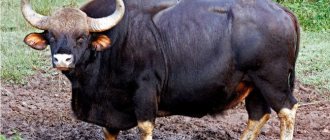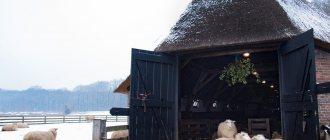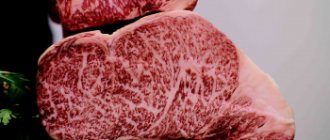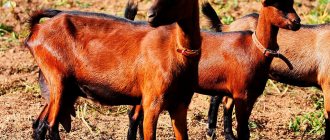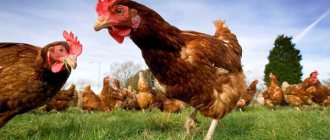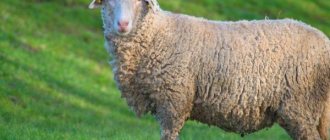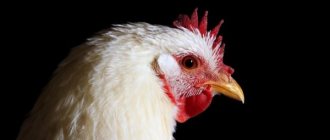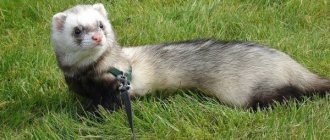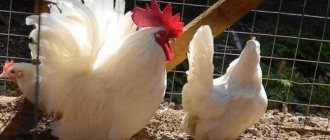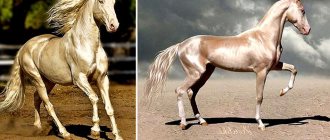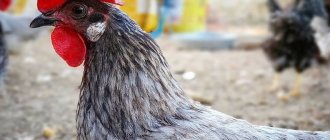Why is the tethered method interesting?
With this method, the barn is divided into separate stalls that correspond to the number of animals. Livestock are brought into such a house for overnight stays (in some cases) and when frost occurs. The stalls are equipped with harnesses on which the animals are secured. Most often, this method is used by owners of meat livestock to slow down the motor activity of individuals. This will allow you to maintain the weight you have gained.
For young animals, stalls are made at least one and a half meters long and at least 0.8 meters wide. For adult livestock – 2x1 m in length and width. As for the size, it is worth focusing on the build of the livestock, and therefore many farmers give preference to mobile structures that can be expanded or narrowed as needed.
Tethered way of keeping
If the farm is purchased ready-made, and it was built during the USSR, then such a structure will have to be erected independently (this is not very profitable financially). Old farms have a number of advantages: they have strong walls, ceilings and floors, which is quite important if cows are constantly tied up indoors.
The tethered method allows not only to limit the mobility of animals, but also to ensure the safety of livestock. Animal instincts often take over cows, and they can begin to behave quite aggressively. To secure the bulls, they do not use ropes, but chains that can hold the producer if something goes wrong.
Another advantage of this technique is the possibility of individual feeding of livestock, taking into account the age, weight and physiological characteristics of the animals. Each stall is equipped with a cow feeder. Young animals feed on milk up to the age of 365 days and gradually switch to the diet of adult animals. The tether restricts the growing cattle and prevents them from taking feed from the calves.
Characteristics of premises for young animals
To maintain the thermal conditions in the calf room, the floor is covered with a layer of straw. With a free-stall rearing method, the young animals develop a better skeleton, and the hooves are covered with dense horn. You can use a separate box for each bull, which is equipped with a feeder and drinker. Its dimensions are usually 190x120 cm.
Stall-walking method
It can be classified as a form of tethered method. Here the animals stay in the barn around the clock, eat food right away, but every day they go for a walk to make long treks over a distance of at least 3 km. Such exercise allows you to work up an appetite and not gain excess weight, which negatively affects the health of individuals and their productive qualities.
During such walks, animals are not allowed to pasture, but are simply driven along special paths. This technique is used on farms where there is no free land for pasture equipment. While the cows are out for a walk, the premises are cleaned and manure is removed by tractor loaders.
Basics
The process of breeding cattle (cattle) is activities for the cultivation and maintenance of farm animals of the Bull subfamily. The purpose of the activity is to obtain meat, milk, hide and wool, use animals as draft power, as well as breeding work.
Keeping cattle is a key activity aimed at meeting humanity's food needs.
The total number of cattle on the planet is about 1.5 billion animals. In modern cattle breeding there are about 300 breeds of cattle. About 50 breeds are used in Russia.
Number of cattle in Russia and distribution by type of farm (data for 2016):
| Farm type | Agricultural organizations | Peasant (farm) enterprises and individual entrepreneurs | Private farms |
| Livestock | 8.356 million heads | 2.380 million heads | 8.017 million heads |
As can be seen from the population data, breeding and keeping cows is effective both as a business and as a private rearing activity at home to produce milk and meat.
Watch this video on YouTube
Cattle breeds
Agricultural and farming organizations may focus on obtaining meat or milk. In Russia, mixed farms predominate, where priority is given to the breeding of meat and dairy breeds.
This approach allows you to quickly respond to market changes and effectively implement a flexible policy when selling dairy and meat products.
| Cattle breed | Origin | Direction | Height (cm) | Weight, kg) | Peculiarities | Value |
| Hereford | England | meat | 125 | 650-1350 | They are hardy, strong, adapted to various climatic conditions, can withstand long journeys and being kept on pastures, and are well fed and fattened. | High-quality marbled meat, slaughter yield - 65% of the total weight, the best meat for steaks. |
| Aberdeen Angus | Scotland | meat | 120-150 | 500-1000 | Excellent feeding ability, adapted to being kept outdoors even in cold weather. | Excellent marbled meat for steaks, yield - 60%, milk production - 2 thousand kg per year. |
| Kholmogorskaya | Russia | dairy | 130-132 | 400- 800 | Adapted to regions with cold climates. | Milk productivity - 3.5-4 thousand kg of milk, fat content - 3.6-3.7%. |
| Ayrshire | Scotland | dairy | 125 | 450-850 | Adapted for breeding in northern regions, it is characterized by constant milk yield, easy adaptation to new conditions, and digests roughage well. | Milk productivity is about 8 thousand kg of milk with a fat content of 4%. |
| Yaroslavskaya | Russia | dairy | 125-127 | 450-550 | Tasty and high-quality milk, adaptability to harsh climates, resistance to diseases (leukemia). | Satisfactory meat qualities, slaughter yield - from 52 to 62%, average milk yield - about 3.2 thousand kg of milk with a fat content of 4.2%. |
| Simmentalskaya | Switzerland | meat and dairy | 135-140 | 550-650 | Adaptability to various climatic conditions, high weight gain throughout the entire growth period. | Optimal combination of meat and dairy qualities. Milk productivity - 3-3.5 thousand kg of milk. |
| Kostromskaya | Russia | dairy and meat | 137-147 | 550-900 | Hardy, have good health and high adaptability, live long and maintain milk yield until old age | Milk yield - 3.5-5 thousand kg of milk with a fat content of 3.8%. |
Other quality cow breeds:
- Dutch;
- black-and-white;
- red steppe;
- Sychevskaya;
- Swiss;
- Kalmyk;
- Bestuzhevskaya;
- Charolais;
- limousine;
- Kazakh white-headed.
Watch this video on YouTube
The characteristics of modern meat and dairy breeds make it possible to effectively breed cows throughout almost the entire territory of Russia. The main conditions are the quality of feed and conditions of detention.
Sanitary requirements
An important condition for cattle breeding is compliance with veterinary and sanitary rules.
Primary requirements:
- maintenance and grazing in strictly designated areas;
- compliance with the rules for protecting cows from other domestic animals;
- availability of ventilation;
- regular cleaning and storage of manure in special places;
- the presence of washing, veterinary and other separate premises necessary for the quality maintenance of cows;
- compliance with the rules for sectional and group placement of cattle;
- availability of walking areas;
- organization of quality feeding;
- regular disinsection (destruction of insects), decontamination (destruction of ticks) and deratization (destruction of rodents) of the barn premises;
- the presence of quarantine zones in barns;
- systematic vaccination on time and regular examination by a veterinarian.
Free-tether technique
This method is most common on dairy farms. The room is a large area without any partitions. It is ideal to keep heifers and young stock as a loose-stall option, which will work up an appetite as they move around the barn. This technology also allows for significant savings on equipment and workers, whose responsibility would be to tether livestock upon returning from pastures. Another advantage of the method is the ability to keep a larger number of livestock than with the stall method.
Free-stall housing can mechanize feeding, which significantly reduces labor costs and money. There is a positive effect on the health of animals: they rarely have back problems, and the hardness of the hoof horn allows them not to be afraid of ailments affecting the limbs.
Untethered method
Cowsheds are equipped with slatted floors. 15-20 individuals can be accommodated in a pen without any problems. Manure removal is carried out mechanically, manually, using a delta scraper or self-alloys.
Floors where animals are kept must be covered with several layers of bedding. Most often, it is not changed every day, but straw is simply added (as the previous ones become dirty). The barn is cleaned with the onset of the warm season and after the end of frost. This method allows you to maintain a microclimate and a certain temperature in the room.
The second name for the loose-leash method is boxing. Here the boxes are combined with pens, and the animals go into them to rest. Most often, young animals who have not yet learned to take care of personal hygiene are kept in pens. In boxes, the animal can lie down on a clean bedding and eat food individually. When arranging stalls, you must not forget about the presence of a slight slope of the floor along which urine will go into the drain.
Features of such a barn: standards and construction plan
The main condition for successfully keeping cows free-stall is having constant access to feed. Haylage, straw and other products are usually stored in walking areas. The floor in the barnyard can be made of slats or covered with bedding (the bedding is changed 1-2 times a year and re-covered daily).
Milking
Milking parlor in the barn
On the farm you will need to set up a milking parlor or a platform specially equipped for this purpose.
Equipment for primary processing and transportation of milk is also located here. The number of places is calculated taking into account the size of the herd. For example, but for 100-200 heads, only 10 milking places are enough.
We recommend paying attention to automatic lines, which significantly speed up the process. It is also possible to set special milking regimes for different groups of animals in the herd.
Dividing the herd
To optimize production processes, the herd is divided into physiological workshops and groups - these are pregnant dry cows, deep-pregnant animals, new cows and individuals with high productivity, low-productivity cattle.
After being transferred to the calving department, deep-boned cows are kept on a tether; tethered housing is also practiced for dry groups. For each category, the barnyard has its own section with a feeding area.
It is advisable to fill loose premises with those animals that have been accustomed to this type of housing since birth.
Animals can also be divided into groups based on the expected calving date. In this case, you will transfer animals from one room to another in groups, which is quite convenient. Please note that the calving area should have three sections - prenatal, birth, postnatal.
Area standards
The area norm per animal is on average 4-5 square meters. They may increase for calving cows.
Feeding
The feeding diet is compiled taking into account their physiological norms. For example, during the dry period, the main thing is to prepare the female for growth and normal lactation. Her diet must be balanced so that the fetus develops normally. There must also be constant access to drinking bowls.
Milking and insemination workshops
The insemination and milking workshop is needed to assess the productivity of animals, their ranking and culling. On average, a cow spends up to 3-4 months in this room.
Insemination is carried out artificially or naturally. In practice, artificial insemination is used more often. In a dairy shop, animals are grouped according to productivity indicators - 3-4 groups are usually sufficient.
Manure removal
The health of animals and the comfort of their conditions in the barn depend on the cleanliness of the bedding. It is most convenient to remove manure in the intervals between feeding groups of herds.
For simple and quick cleaning of premises where animals are kept, it is recommended to make floors with a slight slope. Be sure to carefully monitor the cleanliness of the bedding, as the comfort and health of the animals depend on it.
Cold way
This development belongs to American livestock farmers. It is important to pay attention to the climatic conditions where the farm is located. Most animal premises in our country are located from north to south in the direction of local winds.
The cold method involves equipping barns with a natural ventilation system, and this can only be achieved if the room is located perpendicular to the direction of the winds.
Air exchange is carried out by installing long slots in the covering, openings in the eaves area and longitudinal walls. This method of ventilation has nothing to do with energy resources, with which problems sometimes arise.
In practice, it has been proven that the success of the technique lies in the correct operation of the ventilation system, because heat comes from animals in the same way as from bedding materials with waste.
When keeping cold, it is worth considering that sub-zero temperatures should not be constant. The maximum value is -27°C outside; animals normally tolerate 15-degree frosts in the barn. Lower temperatures require increased feeding of livestock, but then you should forget about raising animals at minimal cost.
Cold way of keeping cows
Until recently, this technology was considered optimal for keeping beef livestock, but not so long ago the cold method began to be used for dairy cattle. A slight reduction in milk yield was detected when animals were in unheated premises.
The presence of thick bedding indoors for animals plays an important role. You can use any materials of the farmer's choice. No matter how well cows tolerate freezing temperatures, they should be able to lie down on dry bedding.
While there are frosts, it is necessary to pour new bedding materials on top of the old ones every 7 days. This method allows you to create a microclimate in the barn that is suitable for animals. The biggest disadvantage is prolonged frosts: here you will have to take care of closing windows and ventilation holes, otherwise the cows may suffer greatly from freezing temperatures (even death).
Differences in raising different groups of cattle
Male and female cattle can be kept together, while providing males with a separate feeding trough. A separate room is allocated for keeping stud bulls. They are tied by the neck, but in no case by the horns or nose ring. Aggressors are removed, and only an experienced worker can care for them.
Advice! Avoid rough handling or raising your voice when caring for bulls.
Long-term confinement causes violence and aggression in the animal, as well as excess fat deposits. A varied and balanced diet is important, which should consist of proteins, vitamins, minerals and a small amount of carbohydrates. Bull drinking troughs should be cleared of excrement and filled with clean water three times a day. It is better to water cattle before feeding.
Pasture method
The use of this method is one of the most profitable in economic terms. The cost of purchasing feed is significantly reduced; in the warm season, animals eat green material, and prolonged exposure of animals to the fresh air has a beneficial effect on the health of the livestock.
Grasslands
Pastures will be profitable only on those farms where there are areas where you can arrange walking. It is best if there are several of them to change. Animals eat up the grass quite quickly, and a depleted pasture will not be able to provide nutritional components in the required quantities, which will significantly reduce production productivity and negatively affect health.
When choosing pasture land, you must not forget about the cows' access to water. This could be a pond located within walking distance, or transportable drinking bowls. If there are no natural shelters on the field, then you need to remember to install canopies that will protect the animals from hot sun rays or rain.
The influence of environmental conditions on livestock care
If a decision is made to breed cattle on a personal plot, then new construction will be required on a private farm: the barnyard must be equipped with three separate structures - a cowshed, a feed shed and a manure storage facility. The construction of buildings should begin with the first object. For beginning farmers unfamiliar with dairy farming technology, maintaining a large number of livestock is difficult. It is recommended to take 5, 10, 15, 20 cows at first. Accordingly, the premises for them must be built as single-row for up to 5 individuals and double-lane if more. The material for building a barn can be anything available in a particular area: wood, brick, cinder block, stone, adobe, etc. The necessary parameters of an industrial barn and a home-made barn are the same and the area is set based on the space for one individual - 3 x 3 meters. More important is the interior arrangement of the room:
- 1. Ventilation – a pipe with a damper that regulates the flow of fresh air. You can make it yourself from boards or purchase ready-made pipes and dampers at hardware stores. The upper end is installed above the roof and protected from precipitation by an umbrella. A wide plate is placed under the lower end to distribute incoming clean air throughout the barn.
- 2. Heating is required for newborn calves. For this, infrared lamps and film heaters of the PLEN series are used. The optimal temperature for adult animals is 8-12ºС.
- 3. Stall – its dimensions in plan are 190 x 140 cm, the height of the side partition is 150. If the cow is kept in it without grazing, then the dimensions of the area are increased by 30%.
- 4. The feeder is made of planed and well-fitted dry coniferous or oak boards. The design should exclude the possibility of injury to the lips and tongue of the cow. The shape resembles a gutter with a width of 50 cm at the bottom and 80 cm at the top. It is installed on the floor or suspended half a meter from it. The volume is determined based on a single feeding or daily norm.
- 5. Drinking bowl - for a small number of heads they put a clean bucket, but when there are more than a dozen of them, they make an automatic device.
- 6. Location of windows and doors - when building from scratch, they should be done on the east and south sides. The light comes from the side or behind the animal's head. There should be no gaps in them, but they must be opened for ventilation. Openings for windows measuring 0.5 x 0.7 m are made above the cow's forehead along the side walls. Modern farms are built using transparent materials. This could be a lantern on the roof of a building.
- 7. Floor construction - its level must be above the ground level on the site. It is advisable to make it adobe and press boards on top.
To complete the arrangement of the barn there is not enough milking machine. For a small farm, you can purchase a portable device.
Flow-shop method
This method means keeping a dairy herd on a farm using either tethered or free-stall methods. More attention is paid here to milking cows.
In the stall method, milk is collected in portable milking machines that have milk lines or buckets. The presence of a milk pipeline makes it possible to reduce the labor costs of milkmaids: one person is able to serve a herd of 50 heads. For comparison: when using buckets, a milker can serve up to 30 cows in the same period of time.
With the free-stall method, milking equipment is installed in a special room where cows come for milking. Here the passages are arranged in such a way that the animals do not mix with the still-milked livestock.
The model of milking machines is selected depending on the number of operators performing milking, the area of the hall, and the number of animals.
Meat sales
With proper organization of fattening, bull calves are ready for slaughter at the age of 6 to 18 months. It all depends on the breed. Before you start slaughtering, you need to agree either with wholesale meat buyers, or with markets and shops, or with restaurants and cafes. There are quite a lot of options for selling meat products.
It is most profitable to sell fresh meat in small batches. But beginning farmers do not always have the opportunity to gather a sufficient customer base in a short time to sell meat in small quantities. Therefore, for beginners, the best option is wholesale. It is also important to consider regionality when marketing meat.
It is best to find buyers from neighboring regions, since with high transport costs, selling beef will be less profitable.
What is a cow split?
Such devices allow for examinations of animals, routine vaccinations and other procedures. In any case, it is necessary to separate and record individuals. When secured, the animal greatly facilitates the work of a veterinarian or livestock specialist; moreover, the cow will not be able to cause damage to itself or the staff.
If necessary, a split is placed in the middle of the passage where the herd will pass, and then the desired animal is separated from it. The most convenient method is using fixation frames. The cow enters the open frame, and then (using a special lever) the gate closes. Thanks to the neck clamp, the neck is securely and securely fixed. Additional levers are used to immobilize the head.
Split
The limbs are secured with straps or clamps. The gate located behind does not allow another animal to enter the split. Once the cow is secured, all necessary procedures can be carried out.
How to keep calves
Young animals of both sexes are kept in the same pen until a certain time. Most often, calves are kept without a leash. This reduces the risk of strangulation if the animal tries to leave the pen.
A thick layer of bedding materials is placed inside, and feeding occurs by allowing the young to be near their mothers for a while. This is how meat breeds are raised. Dairy calves are transferred to artificial feeding.
From the age of 14–21 days, young animals can be driven to pasture lands or to a walking area if there are good weather conditions. From the same time period, the accustoming of animals to the feed of adult livestock begins. The duration of the milk period (if possible) is extended for a year.
Calves and adult livestock must be kept separately in order to provide the younger generation with food, as well as for the safety of the young animals (some adults can be aggressive).
Purchase of livestock
The first step is purchasing livestock. In order for animals to gain weight quickly, they must be healthy and have healthy parents. Therefore, it is very important to buy fattening bulls from breeding farms with a good reputation and healthy livestock. It is better to arrive in advance and inspect the animals, as well as their living conditions. The best time to buy livestock is late spring. It is also worth deciding in advance on the breed of meat animals, because the final meat productivity and the price of young animals depend on it.
Among the meat breeds, black-and-white, white-headed Kazakh, Hereford, and Charolais are very popular among farmers. The average cost of one calf is about 15,000 rubles.
You should not start working with a large number of livestock right away. For the first experience, it is enough to purchase no more than ten animals. This amount is enough to master the basics and understand all the subtleties and nuances of the matter. It is better to give preference to young bulls rather than dairy calves. Calves are cheaper, but require additional costs for milk and special feed. Before purchasing, you should consult a veterinarian and check all necessary vaccinations.
Keeping fattening bulls and sires
Fattening of animals to obtain meat products is carried out in a special feeding zone, here a one-year-old animal can be raised up to 500 kg. Normal conditions do not allow one to achieve such a weight.
The feeding area is divided into stalls and fenced with large thick pipes. You can keep up to 15 heads in one zone. The size of the area is calculated based on the age group of the animals. Too many bulls in a small area leads to deterioration in their health. Feeding boxes are assembled from galvanized or steel pipes - other materials do not have the required strength and will not be able to hold strong animals.
Producer bulls
The size of the feeding box is reduced to the minimum (if it contains one animal). Such measures do not allow the bull to move freely around the cage, which contributes to the rapid gain of muscle mass.
Separate stalls are set up for breeding bulls, where there are locking chains that will allow the animal to lie down and get up without hindrance.
We invite you to join our Zen channel and group on VKontakte or Odnoklassniki, where new articles are published, as well as news for gardeners and livestock breeders.
Similar articles:
- Automation of cow feeding technology: how does it work?
- How to choose effective feed for farm animals
- Winter grazing season, what do Canadian farmers offer?
Free-stall or combined housing of cattle
This variation of keeping dairy cattle is considered the most cost-effective and combines the advantages of tethered and free-tethered systems.
On the one hand, there is no need to tie up animals every time, on the other hand, an individual approach to organizing feeding and reducing feed consumption is possible. Box housing simplifies veterinary control and barn cleaning.
The space available is used as efficiently as possible. Animals are kept separately, contact time is reduced to a minimum, and accordingly, the stress load and injuries are naturally reduced. Milking is done in the milking parlor.
The standard sizes of individual boxes are tied to the size of the animals.
The length of the box should be approximately 10 cm less than the cow's body length so that the droppings will initially fall into the manure collection troughs. The width of a box type stall does not exceed one meter so that the cow cannot turn around within the box.
Partitions made of metal pipes with a diameter of 1.5-2 inches are installed between the boxes.
The height of the partitions must be at least a meter. The floor is covered with asphalt, expanded clay-bitumen or boards. To insulate the floor and prevent injuries to animals, special rubber mats are produced, but they have not yet replaced traditional bedding materials. In most farms, the floor is covered with sawdust, peat or chopped straw.
The floor level of the boxes is 25-30 cm higher than the general level in the hall. Thanks to this design feature, manure collection is simplified. The recommended height is considered optimal when
When resting on a hill, a cow does not lie down in her own excrement. It is not advisable to raise the floor higher than recommended, as the risk of injury to the limbs increases.
To save bedding, boxes can also be equipped with slatted floors. The width of the slats for slatted floors is 80-120 mm.
The slats are attached in increments of no more than 40 mm to prevent accidental hoof injuries in cows. To install slatted floors, choose durable materials that are resistant to disinfectants, non-slippery and without sharp corners.
The introduction of combined technology is possible in any standard barn. To implement it, a relatively minor modernization of the stalls will be required.
